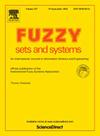Fuzzy neighborhood based variable-precision granular-ball rough sets with applications to feature selection
IF 3.2
1区 数学
Q2 COMPUTER SCIENCE, THEORY & METHODS
引用次数: 0
Abstract
Granular-ball computing is an efficient, simple and scalable computing paradigm that has emerged in recent years. By sampling the data with multiple divisions, the knowledge on different granularity levels is obtained, so as to achieve the purpose of multi-granularity data analysis. As a representative model of granular-ball computing, granular ball neighborhood rough set model (GBNRS) offers greater generality and flexibility as it can adaptively generate different neighborhood radii for each object. However, GBNRS consistently sets the purity degree with 1 for all granular-balls, which may lead to poor fault tolerance in uncertain information systems. Additionally, GBNRS lacks effective approximation operators, making it hard to effectively characterize the differences among samples. For these reasons, a new variable-precision rough set model is set forth by combining granular-ball rough sets, fuzzy rough sets and neighborhood rough sets. To this end, a granular-ball fuzzy neighborhood is presented to reflect the similarity of the samples and a pair of variable-precision approximation operators is formulated to improve the noise-tolerant ability. On this basis, a new granular-ball rough set model i.e. fuzzy neighborhood based granular-ball rough sets (FNGBRS) is proposed. Furthermore, a variable-precision dependency function is introduced to evaluate the classification ability of a given feature sets at different granularity levels. The dimensionality reduction of decision systems is carried out under the condition of keeping the classification ability unchanged, and a feature selection algorithm is developed by using the variable-precision dependency function. Numerical experiments on 12 different types of datasets demonstrate that the proposed model outperforms some state-of-the-art feature learning algorithms in terms of classification accuracy and the number of selected features.
基于模糊邻域的变精度颗粒球粗糙集及其在特征选择中的应用
颗粒球计算是近年来出现的一种高效、简单和可扩展的计算范式。通过对数据进行多分区采样,获得不同粒度层次上的知识,从而达到多粒度数据分析的目的。作为颗粒球计算的代表模型,颗粒球邻域粗糙集模型(GBNRS)可以自适应地为每个目标生成不同的邻域半径,具有较好的通用性和灵活性。然而,GBNRS对所有颗粒球的纯度都一致设置为1,这可能导致不确定信息系统的容错性较差。此外,GBNRS缺乏有效的近似算子,难以有效表征样本间的差异。为此,将颗粒球粗糙集、模糊粗糙集和邻域粗糙集相结合,提出了一种新的变精度粗糙集模型。为此,提出了一个颗粒球模糊邻域来反映样本的相似性,并构造了一对变精度逼近算子来提高样本的抗噪能力。在此基础上,提出了基于模糊邻域的颗粒球粗糙集(FNGBRS)模型。此外,引入了变精度依赖函数来评估给定特征集在不同粒度级别上的分类能力。在保持分类能力不变的条件下对决策系统进行降维,并利用变精度依赖函数开发了一种特征选择算法。在12种不同类型的数据集上进行的数值实验表明,所提出的模型在分类精度和选择的特征数量方面优于一些最先进的特征学习算法。
本文章由计算机程序翻译,如有差异,请以英文原文为准。
求助全文
约1分钟内获得全文
求助全文
来源期刊

Fuzzy Sets and Systems
数学-计算机:理论方法
CiteScore
6.50
自引率
17.90%
发文量
321
审稿时长
6.1 months
期刊介绍:
Since its launching in 1978, the journal Fuzzy Sets and Systems has been devoted to the international advancement of the theory and application of fuzzy sets and systems. The theory of fuzzy sets now encompasses a well organized corpus of basic notions including (and not restricted to) aggregation operations, a generalized theory of relations, specific measures of information content, a calculus of fuzzy numbers. Fuzzy sets are also the cornerstone of a non-additive uncertainty theory, namely possibility theory, and of a versatile tool for both linguistic and numerical modeling: fuzzy rule-based systems. Numerous works now combine fuzzy concepts with other scientific disciplines as well as modern technologies.
In mathematics fuzzy sets have triggered new research topics in connection with category theory, topology, algebra, analysis. Fuzzy sets are also part of a recent trend in the study of generalized measures and integrals, and are combined with statistical methods. Furthermore, fuzzy sets have strong logical underpinnings in the tradition of many-valued logics.
 求助内容:
求助内容: 应助结果提醒方式:
应助结果提醒方式:


